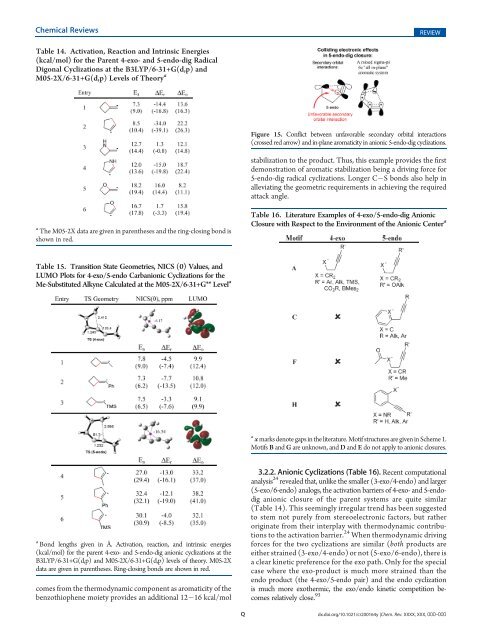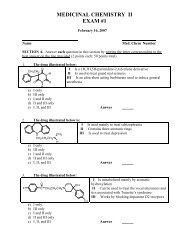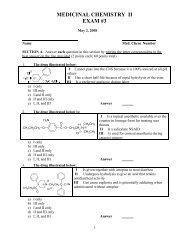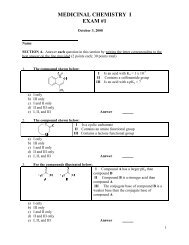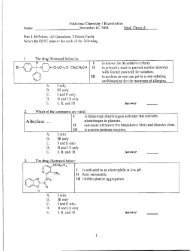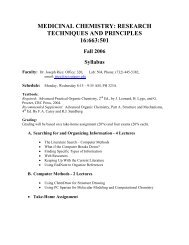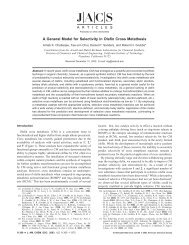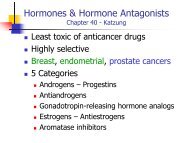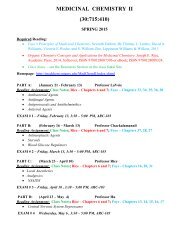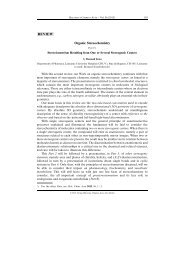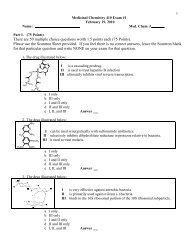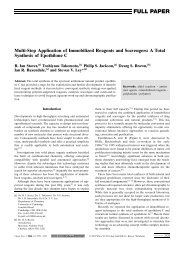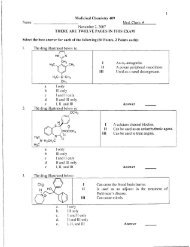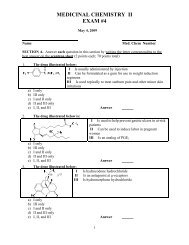Baldwin's Rules - Department of Medicinal Chemistry
Baldwin's Rules - Department of Medicinal Chemistry
Baldwin's Rules - Department of Medicinal Chemistry
Create successful ePaper yourself
Turn your PDF publications into a flip-book with our unique Google optimized e-Paper software.
Chemical Reviews REVIEW<br />
Table 14. Activation, Reaction and Intrinsic Energies<br />
(kcal/mol) for the Parent 4-exo- and 5-endo-dig Radical<br />
Digonal Cyclizations at the B3LYP/6-31+G(d,p) and<br />
M05-2X/6-31+G(d,p) Levels <strong>of</strong> Theory a<br />
a<br />
The M05-2X data are given in parentheses and the ring-closing bond is<br />
shown in red.<br />
Table 15. Transition State Geometries, NICS (0) Values, and<br />
LUMO Plots for 4-exo/5-endo Carbanionic Cyclizations for the<br />
Me-Substituted Alkyne Calculated at the M05-2X/6-31+G** Level a<br />
a Bond lengths given in Å. Activation, reaction, and intrinsic energies<br />
(kcal/mol) for the parent 4-exo- and 5-endo-dig anionic cyclizations at the<br />
B3LYP/6-31+G(d,p) and M05-2X/6-31+G(d,p) levels <strong>of</strong> theory. M05-2X<br />
data are given in parentheses. Ring-closing bonds are shown in red.<br />
comes from the thermodynamic component as aromaticity <strong>of</strong> the<br />
benzothiophene moiety provides an additional 12 16 kcal/mol<br />
Figure 15. Conflict between unfavorable secondary orbital interactions<br />
(crossed red arrow) and in-plane aromaticity in anionic 5-endo-dig cyclizations.<br />
stabilization to the product. Thus, this example provides the first<br />
demonstration <strong>of</strong> aromatic stabilization being a driving force for<br />
5-endo-dig radical cyclizations. Longer C S bonds also help in<br />
alleviating the geometric requirements in achieving the required<br />
attack angle.<br />
Table 16. Literature Examples <strong>of</strong> 4-exo/5-endo-dig Anionic<br />
Closure with Respect to the Environment <strong>of</strong> the Anionic Center a<br />
a x marks denote gaps in the literature. Motif structures are given in Scheme 1.<br />
Motifs B and G are unknown, and D and E do not apply to anionic closures.<br />
3.2.2. Anionic Cyclizations (Table 16). Recent computational<br />
analysis 24 revealed that, unlike the smaller (3-exo/4-endo) and larger<br />
(5-exo/6-endo) analogs, the activation barriers <strong>of</strong> 4-exo- and 5-endodig<br />
anionic closure <strong>of</strong> the parent systems are quite similar<br />
(Table 14). This seemingly irregular trend has been suggested<br />
to stem not purely from stereoelectronic factors, but rather<br />
originate from their interplay with thermodynamic contributions<br />
to the activation barrier. 24 When thermodynamic driving<br />
forces for the two cyclizations are similar (both products are<br />
either strained (3-exo/4-endo) or not (5-exo/6-endo), there is<br />
a clear kinetic preference for the exo path. Only for the special<br />
case where the exo-product is much more strained than the<br />
endo product (the 4-exo/5-endo pair) and the endo cyclization<br />
is much more exothermic, the exo/endo kinetic competition becomes<br />
relatively close. 93<br />
Q dx.doi.org/10.1021/cr200164y |Chem. Rev. XXXX, XXX, 000–000


